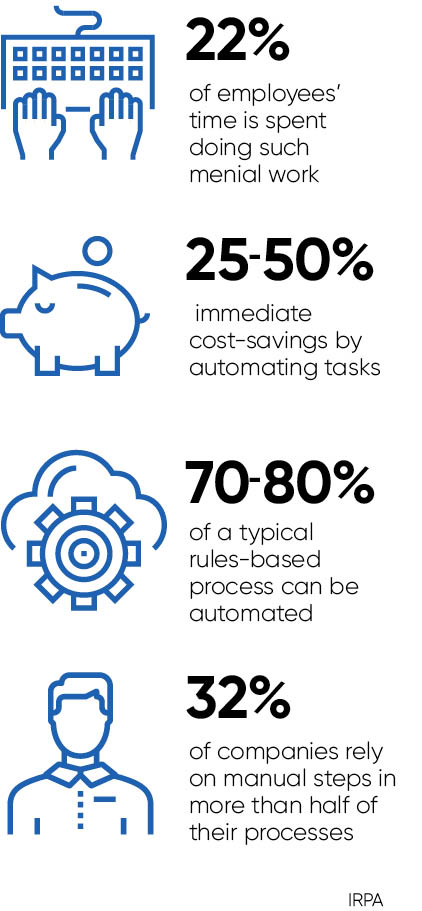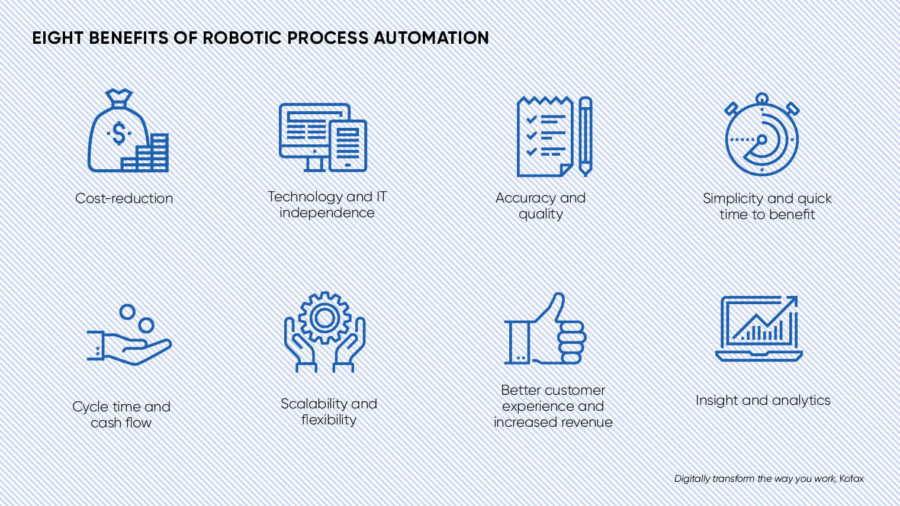Businesses are increasingly realising that much of their human capital is wasted on manual, repetitive tasks. A sizeable 22 per cent of employees’ time is spent doing such menial work, according to research by Cognizant. Previously, this was not considered unproductive activity as there was no alternative, but recent advances in automation technology have made robotic assistance a workplace reality.
Inefficiencies from manual tasks impact every part of a business, reducing productivity, slowing customer response times, increasing labour costs and resulting in data-entry errors. The Institute for Robotic Process Automation (IRPA) claims that out of every one hundred steps, a human is likely to make ten errors, even when carrying out somewhat redundant work.
 Robotic process automation (RPA) is an emerging technology that automates all the manual, repetitive tasks that waste employees’ time. It uses software robots and intelligent business rules to mimic specific actions that employees take while performing tasks in various applications. This eliminates countless hours copying, pasting and switching between systems, applications, spreadsheets, websites and other data sources.
Robotic process automation (RPA) is an emerging technology that automates all the manual, repetitive tasks that waste employees’ time. It uses software robots and intelligent business rules to mimic specific actions that employees take while performing tasks in various applications. This eliminates countless hours copying, pasting and switching between systems, applications, spreadsheets, websites and other data sources.
“By leveraging RPA, organisations can make better-informed decisions, much more quickly, but in a consistent manner,” says Owen Kilbane, robotics sales specialist at Kofax. “Our solution can be deployed to automatically pull information from all of a company’s different sources and systems in a consistent, controlled and compliant manner.
“With organisations now relying on interacting with web-based applications like Salesforce, Workday and Office 365, as part of an overall business process, there is a greater requirement to leverage native automation across desktop applications, mainframe systems and web-based applications. In essence, the robots are our agents going out and pulling key information back into your business processes.”
DIGITAL COMPANIONS
RPA can be deployed for virtually any business activity involving users, data and systems, and because it does not rely on the use of complex application programming interfaces or APIs and coding, it can be deployed in a matter of weeks. By integrating with existing technology, it is complementary to core systems and non-disruptive to day-to-day operations. RPA also augments and complements business process management and case management automation platforms.
By automating routine tasks, businesses can increase workflow efficiencies, freeing up staff for higher-value work, driving down costs and boosting revenue. In Cognizant’s study, half of organisations said automation will significantly improve their processes over the next five years as they seek to become more competitive, responsive and agile. By gaining quicker insights into their business and market, they can better meet customer needs.
RPA creates immediate cost-savings of between 25 per cent and 50 per cent by automating tasks at a fraction of the human equivalent, according to the IRPA. By removing menial tasks from staff duties, it can also boost employee satisfaction, and use cases have demonstrated substantial increases in productivity, service levels and capacity.
“When RPA is server-based, it can deliver real value to the organisation using it and to the end consumer when you’re dealing with client-facing applications, as you can deploy multiple robots concurrently as part of an integrated seamless customer experience,” says Mr Kilbane.
RISE OF THE ROBOTS
RPA has emerged as a golden opportunity in a range of industries. Edge Research found that half of manufacturers still use manual processes for monitoring changes, exceptions and disruptions to their supply chain and plan activity. And according to PayStream Advisors, 47 per cent of accountants say manual data entry and inefficient processes are their biggest challenge. A typical rules-based process can be automated by between 70 and 80 per cent.
In the transportation and logistics industry, even small delays or discrepancies can have costly consequences, but 32 per cent of companies rely on manual steps in more than half their processes, according to Eyefortransport. With global supply chains becoming more and more complex, gaining insight into shipments and inventory is a growing challenge.
We have been able to reduce the turnaround time for digitising loan documents from fifteen days to five days
Order tracking at UK logistics firm Davies Turner was previously a reactive and manual process, taking around 15 minutes to respond to each request. “We have thousands of shipments coming in and out of our facilities every day, and if a customer contacts us to ask where a particular order is and what state it’s in, we need to give them that information fast,” says Darren Gurney, logistics systems manager at the company. “We wanted to be more proactive and provide all customers with up-to-the-minute insight into their orders instead of waiting until they came to us with a query.”
Using Kofax’s RPA solution, Davies Turner implemented software robots that perform data extraction and integration tasks, enabling the company to offer customers alternative ways to communicate with them. The robots automatically capture reference and tracking numbers as each order is entered into the company’s warehouse management system. They regularly query carrier tracking systems and websites to retrieve delivery status and proof-of-delivery information, and link this data to the original order record.
The software robots have helped Davies Turner to deliver faster and more responsive service. “Our teams now answer requests for information on a shipment in real time, increasing the number of shipments we track by 1,000 per cent without adding staff,” says Mr Gurney. “Kofax has eliminated tedious manual work and has made people’s jobs easier – and all without introducing any major changes to the way teams work.”
RPA is also being heavily utilised in the financial services industry, for example helping Union Bank to speed up the process of packaging and selling mortgage loans. Kofax’s solution allowed the bank to move 800,000 loan documents scanned by its contractor into its central system of record in a matter of days.

“Without Kofax, it probably would have taken several weeks to migrate everything and the complexity of the project would have increased the cost significantly,” says Reginald L. Brown, a senior vice president at Union Bank. “We have been able to reduce the turnaround time for digitising loan documents from fifteen days to five days.”
Davies Turner, Union Bank and many other organisations have discovered not just the power of RPA when it comes to driving significant efficiencies and results in areas where manual processes previously drained time and resources, but also the importance of the technology in delivering overall process automation across the business. Companies that view robotics as complementary to their customers, employees and overall business strategy will ultimately excel in the age of automation.
For more information please visit www.kofax.com
